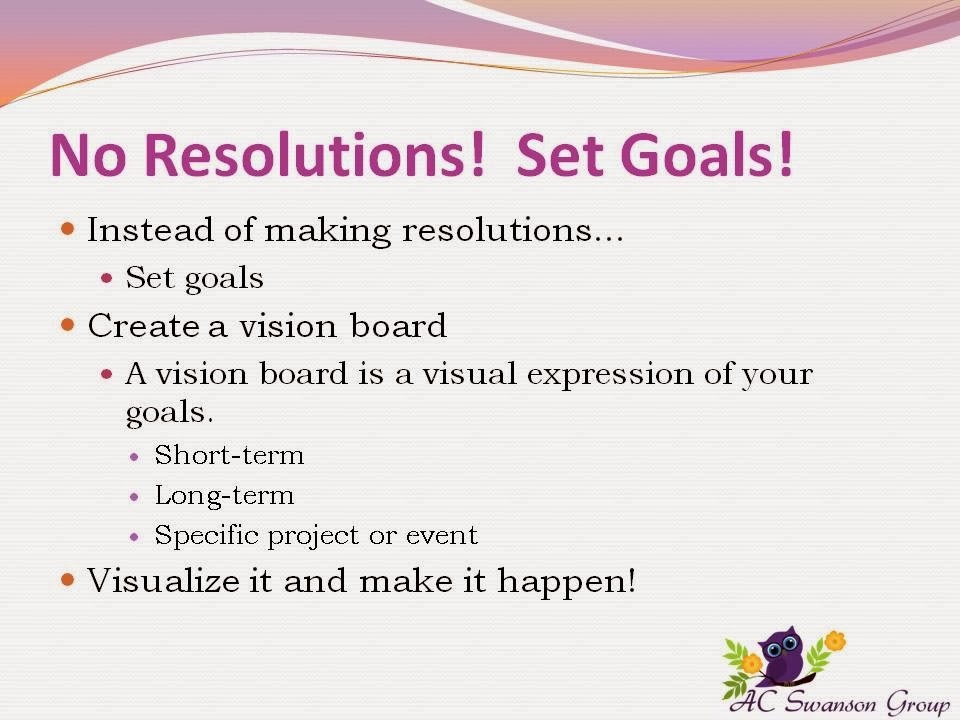New Years is the that special day where people boastfully pronounce their resolutions to any passerby who will listen. Like most New Year's resolutions they are short lived and die off in a few short weeks after pronouncement. This year, instead of making resolutions, look to bring in the new year with some well thought out goals. This will help you give your life a kick in the pants as you march down a brighter path.
Goals are different than resolutions. Resolutions usually seek to solve a problem and are not always well thought out. This is one reason why resolutions don't often have staying power. Goals are a commitment to achieve some objective and require greater thought and action to successfully achieve.
A popular New Year's resolution is to work out and get into shape. With no real plan in place you walk into your closest gym and sign up for that expensive gym membership that will continue to charge you even though you don't go anymore. You also buy yourself a new pair of running shoes, a great outfit and the latest book catering to some new diet fad. Your ready to go!
Within a few short weeks you abandon the gym and return back to your old habits because you didn't realize there was a lot of work involved in your broad resolution. At the end of it all you spent a lot of money, your enthusiasm quickly died and you eventually gave up. New Year's Resolution "get in shape" died quickly.
Setting a goal may help you more as you will be forced to think through not only the goal but how you manage to achieve it. It is beneficial to take time considering what is important to you and then break down the steps you will need to fulfill your goal. Make sure that your goals have some end point where new goals can be met. Your New Year's Resolution should move from "get in shape" to "lose five pounds" this year.
Steps to Setting Goals
Step 1: Set your goals based upon those things that are really important to you.
Step 2: Goals should have a clearly defined end point like five pounds, volunteer 30 hours, etc...
Step 3: Break your goals down into action steps that require smaller completable steps (i.e. read one health book a month or frequent the gym 30 minutes 3X a week).
Step 4: Assess your goal achievement a few times throughout the year to ensure that you are on track or need to adjust your effort to put yourself on track.
Step 5: Set new goals at the end of the year and celebrate whatever you did happen to accomplish last year.
The blog discusses current affairs and development of national economic and social health through unique idea generation. Consider the blog a type of thought experiment where ideas are generated to be pondered but should never be considered definitive as a final conclusion. It is just a pathway to understanding and one may equally reject as accept ideas as theoretical dribble. New perspectives, new opportunities, for a new generation. “The price of freedom is eternal vigilance.”—Thomas Jefferson
Showing posts with label goal setting. Show all posts
Showing posts with label goal setting. Show all posts
Wednesday, December 31, 2014
Friday, January 3, 2014
Don’t Make Resolutions! Set Goals!
By Dr Andree Swanson
Another new year and guess what I received in the mail? Jenny Craig, Weight Watchers, 24-hour Fitness
and a whole slew of advertisements that weigh in on (no pun intended) those
people who believe in the power of the New Year’s Resolution. While surfing Facebook, a family member
posted that she had to park a mile away from the gym. In a month, parking will return to normal.
To affect change, you must change your behavior. Norcross, Ratzin, and Payne (1989) conducted
a study on 213 adults who made New Year’s resolutions. “Successful resolvers were also found to
report employing significantly more behavioral strategies and less self-blame
and wishful thinking than unsuccessful resolvers” (Norcross, Ratzin, &
Payne, 1989, Abstract).
Consider
creating a vision board, instead of making New Year’s resolutions. This is not only fun to make, but can be a
constant reminder of your focus for the year.
(I used to do this on a large post-it note on my wall).
 |
| Picture provided by Dr. Andree Swanson |
Here are
some tips on how to proceed with your Vision Board.
 |
| Picture provided by Dr. Andree Swanson. |
To learn
more about creating a vision board, visit:
Reference
Norcross, J. C., Ratzin, A. C.,
& Payne, D. (1989). Ringing in the New Year: The change processes and
reported outcomes of resolutions. Addictive behaviors, 14(2), 205-212.
Saturday, January 26, 2013
Book Review: Goal Setting: A Motivational Technique that Works!
It discusses how goal setting has become supported by science as a plausible method of developing higher forms of activity within organizations. Such concepts as laboratory testing as well as real world validity have been assessed to lend credibility to the overall work. Through these studies the advantages of goal setting include productivity, performance, clear expectations, thwarting of boredom, task satisfaction, performance satisfaction, recognition options, competition, and self-confidence.
There is also some practical advice on how to set goals. The book suggests:
1.) Specify the general objective or tasks to be completed.
2.) Specify how the performance in question will be measured.
3.) Specify the standard or target to be achieved.
4.) Specify the time span.
5.) Rate goals as to difficulty and importance.
The work offers root explanations on how to successfully set goals and encourage both productivity and motivation in the workplace. It is a must read for any person who desires to work in business. Through understanding such basic concepts one can understand a greater method organizational improvement. The work is written at a college degree level and is fairly easy to read and understand. It is an important book to put in your library. Lots of references for expanded reading are included.
Locke, E. & Latham, G. (1984). Goal Setting: A Motivational Technique that Works! Prentice Hall: New Jersey. ISBN 0-13-357467-9
Pages: 171
Blog Ranking: 4.8/5 (no age penalty as it is a root theory book).
Cost: $104 New $20 Used
Friday, January 11, 2013
Goal Setting and Motivated Behavior in the Workplace
Goal directed behavior exists within the motivational aspirations of the employee. Nearly all behavior is seen as having some goal or objective that is striving to be fulfilled. Focused goal directed behavior is not driven by environmental conditioning or instinct alone (Locke, 1997). Such behavior must be made through the free choice of options and turned from thoughts into actions. It has a specific goal outcome that employee hopes to achieve by putting forth the energy into a strategy that finally reaches its desired outcome.
Employees will set all types of goals throughout their entire spectrum of influence. Management's job is to help employees ensure that those goals that pertain to the workplace are appropriate for both the employer and employee. Through such directed goals organizations can seek higher levels of alignment between employee actions and organizational needs. True alignment exists when the totality of employee goals further foster the strategic objectives of the organization.
There are three major theories management can use to encourage higher levels of goal alignment and performance in organizations. According to Lock the theories include Management by Objectives, Human Relations and Valence-Instrumentality-Expectancy (VIE) Theory and Job Enrichment and Organizational Behavior Modification (OB Mod)(Locke, 1978). They are as follows:
1.) Management by Objectives (MBO): Under this theory each employee works toward the fulfillment of tasks each day (Taylor, 1911). Through coaching, counseling and oversight employees can be encouraged to meet targeted objectives. As employees are often motivated by rewards the piecemeal rate was developed.
2.) Valence-Instrumentality-Expectancy (VIE) Theory: Victor Vroom believed that valence, expectancy, and instrumentality lead to employees avoiding pain and moving toward motivational pleasure (Vroom, 1964). People exert effort to complete tasks that have workplace outcomes. Valence can be described as the need, expectancy as the expected outcome and instrumentality is the workplace result/reward. Later work includes task/goal setting to achieve outcomes.
3.) Cognitive Growth and OB Mod: Maslow and Herzberg believed that workers have a need to develop a genuine sense of self-worth (Herzberg, 1966). Through appropriate goal setting, feedback, and job enrichment employees can continue to expand their abilities and skill which leads to feelings of self-worth. The theory later included specific goal setting to help employees move in the right direction for self-evaluation.
Each of these theories provide some level of insight into the motivational aspects of behavior within the workplace. It is necessary for employees to first want to achieve some objective and then put their effort toward the achievement of that objective. Each of the theories eventual included goal setting as a method of directing employees along a particular path.
Herzberg, F. (1966). Work and the nature of man. Cleveland: World Publishing Company
Locke, E. (1978). The ubiquity of the technique of goal setting in theories of and approaches to employee motivation. Academy of Management Review, 3 (3).
Locke, E. (1977). The myths of behavior mod in organizations. Academy of Management Review, 2.
Taylor, F. (1911). The principles of scientific management. New York: Norton.
Vroom, Victor H. (1964). Work and motivation. John Wiley & Sons, Inc
Employees will set all types of goals throughout their entire spectrum of influence. Management's job is to help employees ensure that those goals that pertain to the workplace are appropriate for both the employer and employee. Through such directed goals organizations can seek higher levels of alignment between employee actions and organizational needs. True alignment exists when the totality of employee goals further foster the strategic objectives of the organization.
There are three major theories management can use to encourage higher levels of goal alignment and performance in organizations. According to Lock the theories include Management by Objectives, Human Relations and Valence-Instrumentality-Expectancy (VIE) Theory and Job Enrichment and Organizational Behavior Modification (OB Mod)(Locke, 1978). They are as follows:
1.) Management by Objectives (MBO): Under this theory each employee works toward the fulfillment of tasks each day (Taylor, 1911). Through coaching, counseling and oversight employees can be encouraged to meet targeted objectives. As employees are often motivated by rewards the piecemeal rate was developed.
2.) Valence-Instrumentality-Expectancy (VIE) Theory: Victor Vroom believed that valence, expectancy, and instrumentality lead to employees avoiding pain and moving toward motivational pleasure (Vroom, 1964). People exert effort to complete tasks that have workplace outcomes. Valence can be described as the need, expectancy as the expected outcome and instrumentality is the workplace result/reward. Later work includes task/goal setting to achieve outcomes.
3.) Cognitive Growth and OB Mod: Maslow and Herzberg believed that workers have a need to develop a genuine sense of self-worth (Herzberg, 1966). Through appropriate goal setting, feedback, and job enrichment employees can continue to expand their abilities and skill which leads to feelings of self-worth. The theory later included specific goal setting to help employees move in the right direction for self-evaluation.
Each of these theories provide some level of insight into the motivational aspects of behavior within the workplace. It is necessary for employees to first want to achieve some objective and then put their effort toward the achievement of that objective. Each of the theories eventual included goal setting as a method of directing employees along a particular path.
Herzberg, F. (1966). Work and the nature of man. Cleveland: World Publishing Company
Locke, E. (1978). The ubiquity of the technique of goal setting in theories of and approaches to employee motivation. Academy of Management Review, 3 (3).
Locke, E. (1977). The myths of behavior mod in organizations. Academy of Management Review, 2.
Taylor, F. (1911). The principles of scientific management. New York: Norton.
Vroom, Victor H. (1964). Work and motivation. John Wiley & Sons, Inc
Subscribe to:
Posts (Atom)